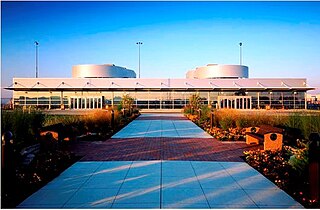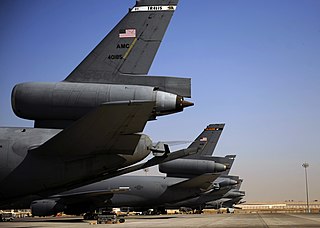
March Air Reserve Base, previously known as March Air Force Base is located in Riverside County, California between the cities of Riverside, Moreno Valley, and Perris. It is the home to the Air Force Reserve Command's Fourth Air Force Headquarters and the host 452d Air Mobility Wing, the largest air mobility wing of the Fourth Air Force. In addition to multiple units of the Air Force Reserve Command supporting Air Mobility Command, Air Combat Command and Pacific Air Forces, March ARB is also home to units from the Army Reserve, Navy Reserve, Marine Corps Reserve, California Air National Guard and the California Army National Guard. For almost 50 years, March AFB was a Strategic Air Command base during the Cold War. The facility covers 2,075 acres of land.

Scott Air Force Base is a United States Air Force base in St. Clair County, Illinois, near Belleville and O'Fallon, 17 miles (27 km) east-southeast of downtown St. Louis. Scott Field was one of 32 Air Service training camps established after the United States entered World War I in April 1917. It is headquarters of Air Mobility Command (AMC) and its showcase wing, and it is also the headquarters of the U.S. Transportation Command, a Unified Combatant Command that coordinates transportation across all the services.

Wilbur Wright Field was a military installation and an airfield used as a World War I pilot, mechanic, and armorer training facility and, under different designations, conducted United States Army Air Corps and Air Forces flight testing. Located near Riverside, Ohio, the site is officially "Area B" of Wright-Patterson Air Force Base and includes the National Museum of the United States Air Force built on the airfield.

Rickenbacker International Airport is a civil-military public airport 10 miles (16 km) south of downtown Columbus, near Lockbourne in southern Franklin County, Ohio, United States. The south end of the airport extends into Pickaway County. The base was named for flying ace and Columbus native Eddie Rickenbacker. It is managed by the Columbus Regional Airport Authority, which also operates John Glenn Columbus International Airport and Bolton Field. Rickenbacker International is primarily a cargo airport for the city of Columbus, although since 2012 it has served an increasing number of passenger flights as well as charter carriers.

Roosevelt Field is a former airport, located 2.3 miles (3.7 km) east-southeast of Mineola, Long Island, New York. Originally called the Hempstead Plains Aerodrome, or sometimes Hempstead Plains field or the Garden City Aerodrome, it was a training field for the Air Service, United States Army during World War I.

Mather Air Force Base was a United States Air Force Base, which was closed in 1993 pursuant to a post-Cold War BRAC decision. It was located 12 miles (19 km) east of Sacramento, on the south side of U.S. Route 50 in Sacramento County, California. Mather Field was one of 32 Air Service training camps established after the United States entry into World War I in April 1917.

Rockwell Field is a former United States Army Air Corps (USAAC) military airfield, located 1.1 miles northwest of the city of Coronado, California, on the northern part of the Coronado Peninsula across the bay from San Diego, California.

The 1st Reconnaissance Squadron is a United States Air Force squadron, assigned to the 9th Operations Group, Beale Air Force Base, California.

The 106th Air Refueling Squadron is a unit of the Alabama Air National Guard 117th Air Refueling Wing. It is assigned to Birmingham Air National Guard Base, Alabama and is equipped with the KC-135R Stratotanker aircraft.

The 108th Air Refueling Squadron is a unit of the Illinois Air National Guard 126th Air Refueling Wing located at Scott Air Force Base, Belleville, Illinois. The 108th is equipped with the KC-135R Stratotanker.

The 116th Air Refueling Squadron is a unit of the Washington Air National Guard 141st Air Refueling Wing located at Fairchild Air Force Base, Spokane, Washington. The 116th is equipped with the KC-135R Stratotanker and RC-26B Metroliner.

The 110th Bomb Squadron is a unit of the Missouri Air National Guard 131st Bomb Wing located at Whiteman Air Force Base, Knob Noster, Missouri. The 110th is equipped with the Northrop Grumman B-2 Spirit.

Grand Central Airport is a former airport in Glendale, California. Also known as Grand Central Air Terminal (GCAT), the airport was an important facility for the growing Los Angeles suburb of Glendale in the 1920s and a key element in the development of United States aviation. The terminal, located at 1310 Air Way, was built in 1928 and still exists, owned since 1997 by The Walt Disney Company as a part of its Grand Central Creative Campus (GC3). Three hangars also remain standing. The location of the single concrete 3,800-foot (1,200 m) runway has been preserved, but is now a public street as the runway was dug up and converted into Grand Central Avenue.

The 2nd Air Refueling Squadron, sometimes written as 2d Air Refueling Squadron, is a unit of the United States Air Force. It is part of the 305th Air Mobility Wing at McGuire Air Force Base, part of Joint Base McGuire-Dix-Lakehurst, New Jersey. The 2nd Air Refueling Squadron is the second-oldest squadron in the Air Force, having over 100 years of service to the nation. It was deployed to the Philippines after World War I, during the 1941-1942 Battle of the Philippines, it was wiped out, with the Japanese forcing some of the personnel to endure the Bataan Death March. It was re-formed as an air refueling squadron by Strategic Air Command in 1949. Today, it operates the KC-46 Pegasus aircraft, conducting aerial refueling missions.

The 911th Air Refueling Squadron is part of the 305th Operations Group, and is stationed at Seymour Johnson Air Force Base, North Carolina. The squadron was the Air Force's very first active duty squadron under the command of a reserve wing. In October 2016, the 911th, formerly geographically separated from the 6th Air Mobility Wing at MacDill Air Force Base, Florida and operated as the active duty associate to the 916th Air Refueling Wing, became the first "I-Wing" or Integrated Wing. In July 2020, it was reassigned to the 305th Operations Group at the McGuire AFB entity of Joint Base McGuire–Dix–Lakehurst, New Jersey.

The 48th Flying Training Squadron is part of the 14th Flying Training Wing based at Columbus Air Force Base, Mississippi. It operates T-1 Jayhawk aircraft conducting flight training. The squadron is one of the oldest in the Air Force, being formed during World War I as the 48th Aero Squadron on 4 August 1917.

Souther Field is a former military airfield, located 3.7 miles (6.0 km) Northeast of Americus, Georgia. It was one of thirty-two Air Service training camps established after the United States entry into World War I in April 1917.

Henry Post Army Airfield is a military use airport located at Fort Sill in Comanche County, Oklahoma, United States. This military airport is owned by United States Army. Established as Post Field in 1917, it was one of thirty-two Air Service training camps established after the United States entry into World War I in April 1917.

The 908th Expeditionary Air Refueling Squadron is a provisional United States Air Force (USAF) unit. It is assigned to the 378th Expeditionary Operations Group as part of the 378th Air Expeditionary Wing at Prince Sultan Air Base in Saudi Arabia. It has supported combat operations in Afghanistan, Iraq, and Syria from its previous location of Al Dhafra Air Base in the United Arab Emirates. The squadron has a varied background, having been formed by a series of consolidations of no fewer than five distinct units.
Maitland Airport, also known as Russell Field is a general aviation airport located in the suburb of Rutherford, approximately 5 km (3.1 mi) from Maitland in the Australian state of New South Wales. There are currently no airline services, with the airfield catering mostly to general aviation and recreational category aircraft. The airport has been owned and operated by the Royal Newcastle Aero Club since 1963 and shares a large training area with the nearby Cessnock Airport. Throughout its history, the airport has played host to many airshows, races and flying competitions. The field is named for the fifth President of the Royal Newcastle Aero Club, Robert Russell, who suffered a fatal heart attack while on the premises in 1966.



















